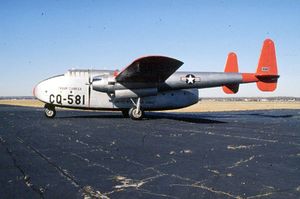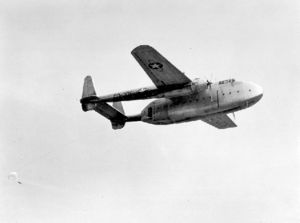PlaneSpottingWorld welcomes all new members! Please gives your ideas at the Terminal.
C-82 Packet
The C-82 Packet was a twin-engine, twin-boom aircraft that was used briefly by the United States Army Air Forces following World War II. Developed by Fairchild, the aircraft was first flown in 1944. Only 223 were ever built, with most used for cargo and troop transport, although a few were used for paratroop operations or towing gliders. During its brief operational life several C-82 Packets were utilized during the Berlin Airlift, primarily bringing assembled vehicles into the city.
Only moderately successful, the C-82 was designed to be used in a number of roles, including cargo carrier, troop transport, ambulance airplane and glider tow. Problems surfaced almost immediately as the aircraft was found to be underpowered and its airframe inadequate for the heavy lifting it was designed to do. As a result the Air Force turned to Fairchild for a solution to the C-82's shortcomings. A redesign was quickly performed under the designation XC-82B, which would overcome all of the C-82A's initial problems. First flown in 1947, the XC-82B would go into production as the C-119B Flying Boxcar. In this respect the C-82 is best remembered as an early developmental stage of the C-119 that saw limited production before being replace by the much improved C-119.
Survivors
Several C-82's remain in Museum collections. The National Museum of the United States Air Force near Dayton, Ohio has had one on permanent display for many years. The last flyable example has been owned and operated by Hawkins & Powers Aviation, an aerial firefighting company located in Greybull, Wyoming. This plane was recently purchased by the Hagerstown Aviation Museum in Hagerstown, Maryland and arrived at the Hagerstown Regional Airport on October 15th, 2006. The plane will remain on display at the HRA until a dedicated space for it is available in a future musuem building to be built near the original Fairchild Manufacturing Facility.
Use in the Media
The C-82 is perhaps best known for its role in the novel, and original film version of "The Flight of the Phoenix" (1965). Based on the novel by Elleston Trevor, the story centers around a C-82 that crashes in the Sahara desert, is rebuilt using one tail boom, and flown to safety. The film version features actors Jimmy Stewart and Richard Attenborough.
Designed to look like a flying C-82 tail boom, the lone Tallmantz Phoenix P-1 (N93082) used in the film was designed by Otto Timm and built by Tallmantz Aviation Inc. Specifications: Length: 45 ft. Wingspan: 42 ft. Engine: Pratt & Whitney R-1340 radial engine of 650 hp taken from a T-6, as were the wheels and various other parts. Wings: wing panels taken from a Beechcraft T-11 (civilian version of an AT-11 Kansan based upon a Beechcraft 18 "Twin Beech"). All visible wing, tail, and undercarriage wire bracing was made out of clothesline, and intentionally made to look flimsy. The fuselage was hand-built from scratch using plywood over wood frame construction.
Taking off was considered dangerous, so legendary stunt pilot Paul Mantz was asked to merely come in low, allowing his landing skid to briefly touch the ground, than lift off again to simulate a takeoff. On the second take the plane crashed and was destroyed, killing Mantz. The main footage had already been shot so a North American O-47A observation plane (N4725V) from the Air Museum was substituted for the remaining close-ups. [1]
Three Fairchild C-82 Packet cargo planes were required for filming and were based at Long Beach Airport in California during the filming. They were operated by Steward-Davis Inc. The flying aircraft was N6887C while the two derelicts were N4833V and N53228. The other aircraft used was a R4Q-1 Navy Packet BuNo.126580.
Specifications (C-82A Packet)
General characteristics
- Crew: three
- Capacity: 42 paratroops or 34 stretchers
- Length: 77 ft 1 in (23.50 m)
- Wingspan: 106 ft 6 in (32.47 m)
- Height: 26 ft 4 in (8.03 m)
- Wing area: 1,400 ft² (130.9 m²)
- Empty: 16,530 lb (12,045 kg)
- Loaded: 42,000 lb (19,050 kg)
- Maximum takeoff: 54,000 lb (24,545 kg)
- Powerplant: 2x Pratt & Whitney R-2800-85 radials, 2,100 hp (1,567 kW) each
Performance
- Maximum speed: 250 mph (400 km/h)
- Range: 2,140 miles (3,424 km)
- Service ceiling: 27,000 ft (8,232 m)
- Rate of climb: 1600ft/min ( m/min)
- Wing loading: 30 lb/ft² (146 kg/m²)
- Power/Mass: 0.10 hp/lb (0.16 kW/kg)
Related Development
- Fairchild C-119 Flying Boxcar
- Fairchild XC-120 Packet
Similar Aircraft
- Chase C-123
Related content
Designation sequence: C-79 - C-80 - C-81 - C-82 - C-83 - C-84 - C-85
Lists relating to aviation | |
|---|---|
| General | Timeline of aviation · Aircraft · Aircraft manufacturers · Aircraft engines · Aircraft engine manufacturers · Airports · Airlines |
| Military | Air forces · Aircraft weapons · Missiles · Unmanned aerial vehicles (UAVs) · Experimental aircraft |
| Notable incidents and accidents | Military aviation · Airliners · General aviation · Famous aviation-related deaths |
| Records | Flight airspeed record · Flight distance record · Flight altitude record · Flight endurance record · Most produced aircraft |


